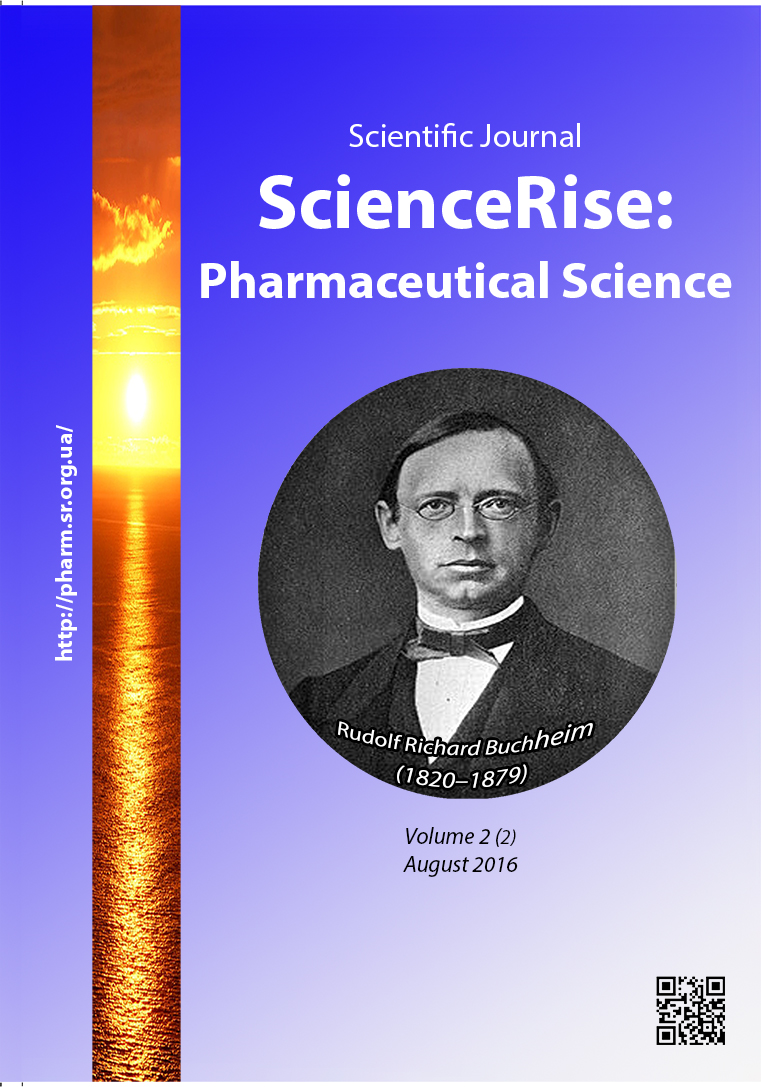Research of irinotecan stability in different methods of active loading into liposomes
DOI:
https://doi.org/10.15587/2519-4852.2016.74454Keywords:
liposomes, Irinotecan, impurities formation, “pH gradient” technology, “ammonium gradient” technology, HPLCAbstract
Irinotecan active encapsulation mechanisms into liposomes according “pH gradient” and “ammonium gradient” technologies were considered.
Aim. Research of Irinotecan stability at typical for each “chemical gradient” technology pH values, and estimation of the impurities content correspondence with Draft quality control methods on " Related impurities” index, using Irinotecan conversion mechanism data.
Methods. HPLC method was used for research, using Shimadzu LC-20 appliance, according to the USP impurities control method for semisynthetic product.
Results. Impurity formation dynamics, similar to Irinotecane E lactone ring destruction product, was studied in 3 stages: at pH values 1.9, 5.0, and 5.5. Impurities formation wasn’t observed at pH 1.9, and Irinotecan was stable during observation period – within 12 hours. At pH 5.0, Irinotecan was stable during 12 hours, while impurities formation in quantity over specifications for the finished product was not observed. At pH 5.5, which is specific for the “ammonium gradient” technology, impurities formation was observed in one hour, which is more than 3 times exceeds permissible norms for impurities content in Liposomal Irinotecan finished dosage form.
Conclusion. It has been found, that in terms of active compound stability, “pH gradient” technology is preferred compared to the “ammonium gradient” technology. After using “pH gradient” technology, “Related impurities” index corresponded to the Draft quality control methods. The obtained data were used for Irinotecan liposomal dosage form development for the further preclinical and clinical study
References
- Prakash, O., Kumar, A., Kumar, P., Ajeet, A. (2013). Anticancer Potential of Plants and Natural Products: A Review. American Journal of Pharmacological Sciences, 1 (6), 104–115. doi: 10.12691/ajps-1-6-1
- Xu, Y. (2002). Irinotecan: mechanisms of tumor resistance and novel strategies for modulating its activity. Annals of Oncology, 13 (12), 1841–1851. doi: 10.1093/annonc/mdf337
- Ramsay, E. C., Anantha, M., Zastre, J., Meijs, M., Zonderhuis, J., Strutt, D. et. al. (2008). Irinophore C: A Liposome Formulation of Irinotecan with Substantially Improved Therapeutic Efficacy against a Panel of Human Xenograft Tumors. Clinical Cancer Research, 14 (4), 1208–1217. doi: 10.1158/1078-0432.ccr-07-0780
- West-Ward Pharmaceuticals Corp. Irinotecan prescribing information (2016). Drugs.com. Available at: https://www.drugs.com/pro/irinotecan.html
- Fassberg, J., Stella, V. J. (1992). A kinetic and Mechanistic Study of the Hydrolysis of Camptothecin and Some Analogues. Journal of Pharmaceutical Sciences, 81 (7), 676–684. doi: 10.1002/jps.2600810718
- Li, W. Y., Koda, R. (2002). Stability of irinotecan hydrochloride in aqueous solutions. Am J Health-Syst Pharm, 59 (6), 539–544.
- Tardi, P. G., Dos Santos, N., Harasym, T. O., Johnstone, S. A., Zisman, N., Tsang, A. W. et. al. (2009). Drug ratio-dependent antitumor activity of irinotecan and cisplatin combinations in vitro and in vivo. Molecular Cancer Therapeutics, 8 (8), 2266–2275. doi: 10.1158/1535-7163.mct-09-0243
- Ramsay, E. (2008). A novel liposomal irinotecan formulation with significant anti-tumour activity: Use of the divalent cation ionophore A23187 and copper-containing liposomes to improve drug retention. European Journal of Pharmaceutics and Biopharmaceutics, 68 (3), 607–617. doi: 10.1016/j.ejpb.2007.08.011
- Egusquiaguirre, S. P., Igartua, M., Hernández, R. M., Pedraz, J. L. (2012). Nanoparticle delivery systems for cancer therapy: advances in clinical and preclinical research. Clinical and Translational Oncology, 14 (2), 83–93. doi: 10.1007/s12094-012-0766-6
- Messerer, C. L. (2004). Liposomal Irinotecan: Formulation Development and Therapeutic Assessment in Murine Xenograft Models of Colorectal Cancer. Clinical Cancer Research, 10 (19), 6638–6649. doi: 10.1158/1078-0432.ccr-04-0221
Downloads
Published
How to Cite
Issue
Section
License
Copyright (c) 2016 Александр Викторович Стадниченко, Юрий Михайлович Краснопольский, Виталий Иванович Швец, Татьяна Григорьевна Ярных

This work is licensed under a Creative Commons Attribution 4.0 International License.
Our journal abides by the Creative Commons CC BY copyright rights and permissions for open access journals.








